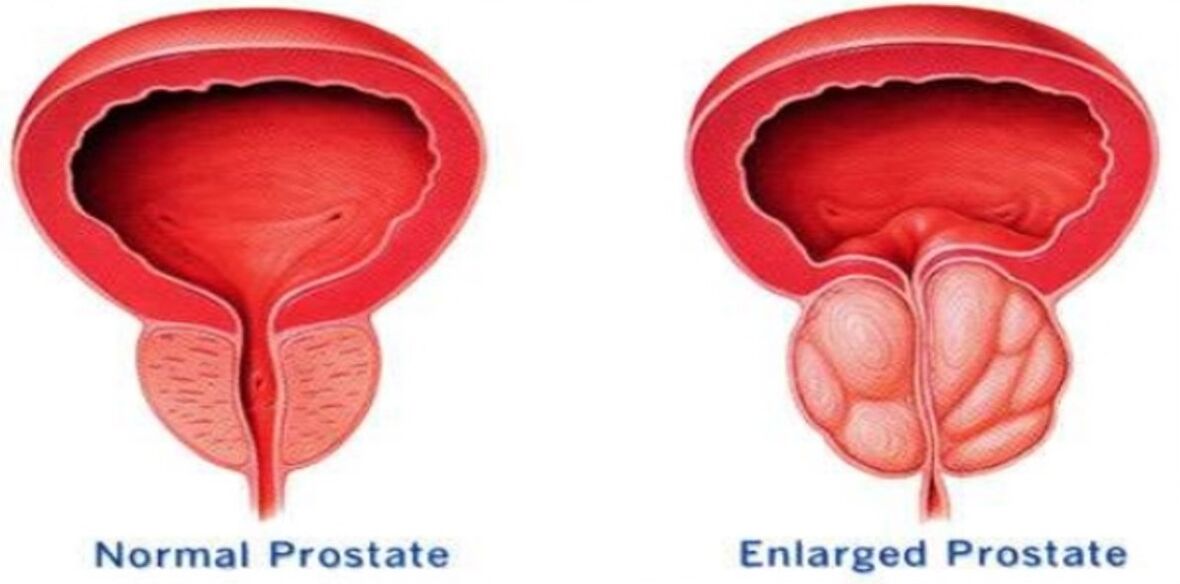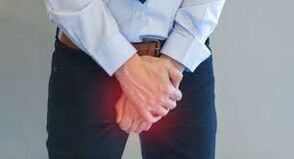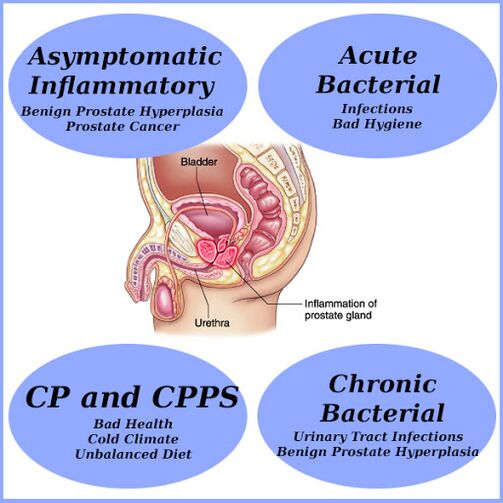Inflammation of prostatitis (prostatitis) is a common disease that occurs after 30 years in more than 80% of men.Lack of obvious symptoms and reluctance to see a doctor can lead to dangerous complications and the formation of chronic forms.Regular preventive tests allow you to identify the disease at the initial stage.The IMMA Clinic creates all conditions to comfortably check and treat prostatitis.Even in the most difficult situations, competent experts can help.
The structure and location of the prostate determines its exposure to infection and inflammation processes.The desire for signs and symptoms of prostatitis leads to unsensible progression, complications, transmission of affected areas to nearby organs.Often, men try not to pay attention to the manifestations of the disease and do not want to seek medical help.This behavior helps the development of the pathogenic process.In this case, the percentage of self-processing is extremely low.

About the prostate
The prostate is one of the most important organs in a person who determines the quality of life to a large extent.
It is an isolated gland located at the base of the bladder.It consists of two shares connected by the isthmus.The main functions of the prostate:
- The production of liquid that dilutes sperm can help create favorable conditions for sperm activity.
- Control urination.The prostate is adjacent to the urethra and performs the function of the sphincter;
- Protect the bladder from ascending infections.
Any disease in the gland can cause problems in the genital area, the urination process.This has resulted in a sharp decline in quality of life.Timely treatment of prostatitis in men will avoid years of complications and maintain sexual activity for many years.
Symptoms of the disease.What to look for?
Prostatitis in men can occur in two forms: acute and chronic.
The characteristics of acute prostatitis are the following clinical pictures:

- The body is poisoned, accompanied by the temperature rises by more than 38 degrees, which is always weak and nauseous;
- Severe pain in the groin area, given on the lower back;
- Difficulty in urinating and defecation.
In this case, the patient's condition requires emergency hospitalization and hospitalization.In most cases, the disease is completely cured.
Symptoms of chronic or stagnant prostatitis are divided into groups:
- pain;
- Infringement of sexual activity;
- Problems during urination.
In the initial stages of disease development, pain manifestations are eliminated, which may occur unpredictable and disappear.Located in the lower abdomen, it spreads to the waist and genitals.The intensity may be low, so the patient may not be careful about the problem.
Important!Pain in the lower abdomen may not only be a sign of prostatitis, but also indicates other diseases of the urine, sexual system and intestinal tract.
The problem that arises is one of the main symptoms of stagnating prostatitis.Their performance boils down to the following:
- Reduced sexual attraction;
- "Erashes" orgasm, lacking a vivid feeling;
- Reduce erections or absences;
- Pain during ejaculation or ejaculation;
- Increase unreasonable night erections.
Psychological state promotes the intensification of the problem.One begins to avoid sexual contact, anxiety, fear and uncertainty.Negative emotional backgrounds enhance signs of sexual dysfunction.
What is particularly unpleasant is the violations in urinary tract work.In the initial stage, urine will be slightly delayed when urinating, and then the symptoms will be enhanced, pain and sculpted, the bladder is full of fullness, and frequent urges appear.This manifestation is explained by the fact that the enlarged prostate begins to put pressure on the bladder and urethra.
The particularity of these characteristics should be considered: the increase in symptoms may cease.For a while, the patient had no problems.This phenomenon is explained by compensatory responses to the bladder muscles.After a short break, the disease manifestation recovered and became more intense.
The development of chronic prostatitis in men may occur unconsciously for several months.Later, identifying threat complications requires not only the participation of drugs, but also surgical treatment.
Important!Stagnation of prostatitis is usually asymptomatic.To identify the disease early, regular preventive examinations are necessary when it is easier to treat.
The nature of the disease.Risk factors

The symptoms and treatment of prostatitis depend on the true nature of the disease.Two main causes are distinguished: infectious lesions and the occurrence of inflammatory processes.
The prostate proximity to the bladder and urinary catheter, the intestine causes the infection to penetrate into the gland tissue.Healthy creatures with strong immunity can successfully withstand infection.The prostate becomes a protective barrier for upward infection that can impress the urine system.This function is weakened due to unhealthy lifestyles and stagnant processes in the pelvis.
The pathogenic organism falls into the prostate along the ascending path of the penis and descends from the bladder through the blood and lymph.Main sources of infection:
- The most dangerous infections are interchangeable.Usually, they are asymptomatic and cause great harm to the body.
- Cystitis;
- colitis;
- Systemic infection;
- ARZ complications, such as bronchitis complications.
The main cause of prostatitis is related to lifestyle errors.Genetic and congenital tendencies are rare cases.
Characteristics of the vascular system structure lead to stagnation in the pelvis, and the blood begins to circulate poorly, and due to its resistance to the disease, the tissue does not obtain the required oxygen, thus reducing it.Furthermore, secrets of the prostate itself may accumulate, which can lead to the inflammatory process.
The stagnation of prostatitis occurs due to the following reasons:
- Congenital characteristics are related to vascular structure, insufficient tone, and weak venous valves;
- Injuries, including injuries to the spine and spinal cord;
- hypoemia;
- Spine disease;
- Varicocele, hemorrhoids;
- bad habits;
- Hormone violations;
- Too much weight;
- Violating salt balance.
Violations in the hormonal background lead to changes in the prostate: excessive testosterone causes it to increase and impaired function.
Bad habits can damage the vascular system.Alcohol can cause small blood vessels to narrow, and nicotine causes ships to wither.Insufficient blood flow helps the development of pathological phenomena in the organs, which is a weakening of its protective function.
A static lifestyle in sitting or standing working or a sedentary lifestyle can cause fluid stagnation in the pelvis, so the venous experience increases the load, and therefore, the venous development of varicose veins, the body's protective function is reduced, and various diseases begin to develop, including inflammation of prostatitis.
Due to frequent diarrhea, colitis, insufficient fluid consumption and lack of potassium, the water-salt balance will be violated, which will adversely affect the state of the prostate gland.
The causes of infectious prostatitis are loose sexual behavior, frequent changes in partners, weak immunity, general infection complications, and hypothermia.
Statistics show a revival of the disease: Young people and adolescents have recorded signs of prostatitis.This is facilitated by wearing careful clothing and linen, frequent hypothermia.
Diagnostic measures
At the time of examination, a doctor suspected of prostatitis interviewed the patient and performed a rectal examination of the prostate.The process does not take much time and is painless.The patient lies aside and the doctor introduces his index finger into the rectum.The prostate and intestinal position allows you to assess its condition.Increased glands, soreness when pressed is a sign of prostatitis.
To confirm the diagnosis, blood and urine tests were performed, including the presence of bacterial infections, ultrasound examinations of the pelvic organs; studies on prostate secretion, and analysis of hormone background.
Main treatment methods
The main method of treating prostatitis is drug treatment.According to the determined reasons, antibiotics are prescribed to fight the pathogens of infection or anti-inflammatory drugs.
They supplement the primary treatment regimen with vitamin complexes, immunomodulators for strengthening blood vessels, hormonal drugs (if necessary).The therapeutic effect is applied by physical therapy.
Sometimes, prostate massage classes are prescribed to eliminate stagnation, helping to restore active work of the organs and improve blood supply.Comments to patients indicate the effectiveness of this type of treatment.The process must not exceed five minutes.Massage is most effective in treating chronic and stagnant prostatitis.
Important!There are many contraindications for prostate massage.This type of treatment is contraindicated in acute prostatitis, suppurative inflammation, and malignant tumors.
Surgical interventions are only possible in extreme cases and are usually performed in older patients, as many serious side effects may occur after gland resection or complete removal of the affected part:
- Infertility;
- Sexual dysfunction;
- Urinary incontinence;
- Hormone violation.
Timely treatment will allow you to quickly respond to the symptoms of prostatitis to avoid life threats and health complications.
Preventive measures
One of the main conditions for alleviating stagnant prostatitis is a healthy lifestyle.Medication will help eliminate symptoms, but if you do not eliminate the real cause, you can observe a recurrence of the disease for a long time.To maintain health, the following recommendations must be followed to avoid chronic diseases:
- Live regularly with a partner;
- Proper nutrition, reject fat, salty, fried;
- Moderate physical exercise;
- Meet the condition of the day and have a healthy sleep;
- Reject bad habits.No matter how familiar it sounds, alcohol and nicotine can greatly affect the entire body.
- Avoid shaking, stay behind the steering wheel for a long time, take a break and be warm.
What can be done?
To avoid the development of chronic forms of the disease and possible complications, it is necessary to perform preventive examinations of urologists twice a year.It is important to choose a clinic and a doctor's choice.The asymptomatic process of the disease requires a series of studies.
Regular visits to a doctor won't take much time, but will help maintain men's health.































